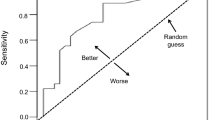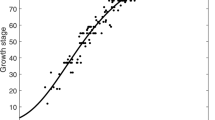Abstract
Bacterial spot caused by Xanthomonas arboricola pv. pruni (Xap) is the most important disease that affects peach production. A disease-forecasting model was developed to help growers decide when to apply bactericides and remove diseased, last-year twigs. To predict the incidence of “spring cankers”, peach twigs damaged by Xap, we used 12 years (2009–2020) of data from Fukushima Prefecture to develop a forecasting system using a hierarchical Bayesian model (HBM). The model included the number of fields with a bacterial spot incidence (BSI) on leaves ≥ 10% in late September of the previous season and the number of days with rain (≥ 10 mm/day) and maximum wind speed (≥ 5 m/s) during the previous October as predictors. Using a best-fit cutoff value based on a receiver operating characteristic (ROC) curve, the model achieved a 0.836 accuracy, 0.804 sensitivity, 0.847 specificity, 0.847 precision, and 0.712 F-measure. The model was validated using a fourfold cross-validation (CV) procedure and achieved an average accuracy of 0.847. Thus, the model explained 65.7% of the variability compared to observed frequencies with predicted probabilities of twig canker incidence (TCI) ≥ 2% from April to May 2009 to 2020 in Fukushima Prefecture. These results suggest that this disease-forecasting model using HBM based on 12 years of historical data can be used to predict the risk of twig cankers of bacterial spot of peach.


Similar content being viewed by others
References
Gelman A, Carlin JB, Stern HS, Dunson DB, Vehtari A, Rubin DB (2014) Bayesian data analysis, 3rd edn. CRC Press, Boca Raton
Hoffman MD, Gelman A (2014) The no-U-turn sampler: adaptively setting path lengths in Hamiltonian Monte Carlo. J Mach Learn Res 15:1593–1623
Hughes G, McRoberts N, Burnett FJ (2015) Information graphs for binary predictors. Phytopathology 105:9–17
Kawaguchi A (2014) Risk factors for bacterial spot on peach in Okayama Prefecture, Japan. J Gen Plant Pathol 80:435–442
Kawaguchi A (2020) Risk factors and assessments for bacterial black node on barley. J Gen Plant Pathol 86:193–198
Kawaguchi A, Inoue K, Inoue Y (2014) Biological control of bacterial spot on peach by nonpathogenic Xanthomonas campestris strains AZ98101 and AZ98106. J Gen Plant Pathol 80:158–163
Mandrekar JN (2010) Receiver operating characteristic curve in diagnostic test assessment. J Thorac Oncol 5:1315–1316
Morimoto R (2011) Occurrence and control of bacterial shot hole on peach (in Japanese). Plant Prot 65:210–214
Ritchie DF (1995) Bacterial spot. In: Ogawa JM, Zehr EI, Bird GW, Ritchie DF, Uriu K, Uyemoto JK (eds) Compendium of stone fruit diseases. APS Press, St. Paul, pp 50–52
Roselló M, Santiago R, Palacio-Bielsa A, García-Figueres F, Montón C, Cambra MA, López MM (2012) Current status of bacterial spot of stone fruits and almond caused by Xanthomonas arboricola pv. pruni in Spain. J Plant Pathol 94(1 Suppl):S1.99-103
Stefani E (2010) Economic significance and control of bacterial spot/canker of stone fruits caused by Xanthomonas arboricola pv. pruni. J Plant Pathol 92(Suppl 1):99–103
Turechek WW, Wilcox WF (2005) Evaluating predictors of apple scab with receiver operating characteristic curve analysis. Phytopathology 95:679–691
Youden WJ (1950) Index for rating diagnostic tests. Cancer 3:32–35
Acknowledgements
This study was supported by a research project of the Ministry of Agriculture, Forestry and Fisheries and a public/private R&D investment strategic expansion program (PRISM) of the cabinet office of Japan. The authors are grateful to Drs. Sun Jianqiang and Shigeki Kishi (RCAIT, NARO, Tokyo, Japan) for much useful advice on statistical analyses using HBM.
Author information
Authors and Affiliations
Contributions
AK and TN conceived and designed the study. AK and TN collected all data. AK contributed to data analysis and led the writing of the manuscript. AK wrote the first draft. AK and TN wrote the second draft, critically reviewed, revised and finalized the manuscript. AK is the principal investigator and guarantor. AK and TN read and approved the final manuscript.
Corresponding author
Ethics declarations
Conflict of interest
The authors declares that they have no conflict of interest.
Ethical approval
This article does not contain any studies with human participants or animals performed by the author.
Additional information
Publisher's Note
Springer Nature remains neutral with regard to jurisdictional claims in published maps and institutional affiliations.
Supplementary Information
Below is the link to the electronic supplementary material.
10327_2021_1032_MOESM1_ESM.pptx
Supplementary file1 Proportion of fields with ≥ 2% of twigs with bacterial spot (canker) in April and May, ≥ 1% on leaves in early July, and ≥ 1% on fruits in late July from 2009 to 2020 (PPTX 40 KB)
Rights and permissions
About this article
Cite this article
Kawaguchi, A., Nanaumi, T. Model-based forecasting of twig canker incidence of bacterial spot of peach in Fukushima Prefecture. J Gen Plant Pathol 88, 41–47 (2022). https://doi.org/10.1007/s10327-021-01032-7
Received:
Accepted:
Published:
Issue Date:
DOI: https://doi.org/10.1007/s10327-021-01032-7




